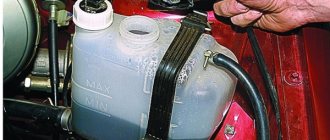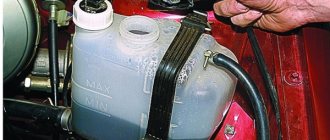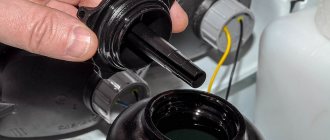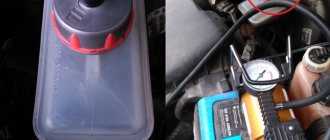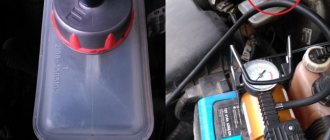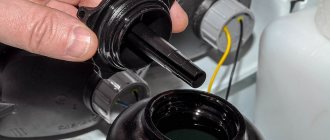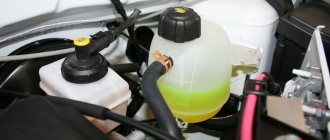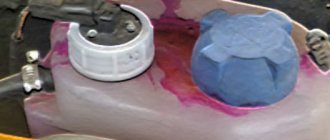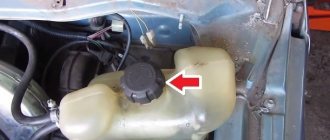Which antifreeze to choose and what volume is needed
To completely change the cooling water in a 2nd generation Lada Kalina/Kalina car, you need 7.8 liters of antifreeze or antifreeze, depending on what you choose. Reddish Felix antifreeze is poured from the factory.
To completely replace the coolant (cooling water), we will need to purchase either one 10-liter canister, or two 5-liter containers.
Choosing antifreeze to replace
If reddish antifreeze was poured from the factory, then we recommend creating a replacement with reddish one.
- AGA 003Z (-40*) reddish 10l cost from 1000 rub.
- Professional Premium G-12 reddish 10 l cost from 700 rub.
- SINTEC LUX G-12 reddish 10l cost from 1000 rub.
- FELIX Carbox-40 (10 l) red price from 950 rub.
- NIAGARA G12 (10 l) red price from 800 rub.
- Arctic Circle G12 (10 l) red price from 700 rub.
All of the manufacturers mentioned above have proven themselves, so antifreeze from these manufacturers can be used for replacement.
What is needed for replacement
- Container for draining old antifreeze for 6-8 liters.
- 16mm head
- 13mm socket wrench for removing the starter on the 16 valve version of Kalina
It is better to create a replacement for a cool engine. Before replacement, you should release the pressure in the system by unscrewing the cap of the expansion tank. In order to freely access the drain plug, you need to remove the middle mud flap.
Choices
When choosing, do not neglect the color of the liquid. The color is intended to indicate certain properties of the antifreeze, so replace it only with an option with an identical color.
Recommended brands of antifreeze include the following products:
- “AGA 003Z” (temperature minus 40 degrees), has a red color, costs approximately 1 thousand rubles. for a 10 liter container.
- “Professional Premium” belongs to the “G-12” category, and the cost of a similar “tank” reaches 700 rubles.
- “SINTEC LUX G-12” is also characterized by a red tint and costs from 1 thousand rubles. for a volume of 10 liters.
- “FELIX Carbox-40”, a canister of the same volume with red liquid will cost the owner from 950 rubles.
- "NIAGARA", substance "G12"; for a volume of 10 liters you will need to pay at least 800 rubles.
- “Arctic Circle”, a substance with similar parameters; A 10-liter container costs at least 700 rubles.
Read also: How to fix a wheel on a stroller
Antifreeze from the above-mentioned manufacturers has proven itself quite well, so you can purchase it without the slightest hint of doubt.
Instructions for replacing Coolant
On Kalinas with 8 and 16 valve engines, the coolant replacement is different. Old fluid can be drained from a radiator without any problems, but from a block on a 16- valve engine it is more difficult. You will have to unscrew the starter.
Replacing the coolant. Kalina
The time has come to change the coolant and the question arose whether to fill in Antifreeze or Tosol
, and how did you do it...
Read:
Features of replacing antifreeze on a Lada Kalina car
Replacing antifreeze
produced after 5 years.
Replacing antifreeze on an 8-valve Lada Kalina engine
So, we relieve the pressure in the system by unscrewing the cap of the expansion tank. Then we remove the motor protection to get to the drain plug.
We take a container with a volume of 6-8 liters. and place it under the drain hole located at the bottom right of the radiator. To make the pressure weaker, screw the expansion tank cap back.
Fill
- It is necessary to ensure complete release of air from the system - the formation of “plugs” sharply reduces the efficiency of the entire structure. To do this, you need to remove the throttle hose by unscrewing the clamp on it;
- Only after this do we begin pouring antifreeze. We pour in a thin stream until we can detect a certain amount of liquid pouring out of the hose;
- Then we attach the hose in place and pour antifreeze into the tank, controlling its level in accordance with the mark. It is recommended not to strive to achieve the risk designated as “maximum” - it is enough to bring the level closer to it;
- After tightening the plug and installing the ignition module in place, we start the engine. Evidence that everything was done correctly will be the fan operating and pumping hot air into the cabin (naturally, the heater must be turned on). If not, we take measures to remove the air lock. Everything was thoroughly analyzed in the article);
- Then you need to turn off the engine and, after waiting for it to cool completely, check the coolant level again. If necessary, add antifreeze to the tank.
Useful expert advice
If the expansion tank cap leaks and does not hold pressure, it should be replaced
- The lid will expand. tank 2108 2108-1311065 Automatic device price from 130 rub.
- The lid will expand. tank 2108 LUZAR LL 0108 price from 100 rub.
- The lid will expand. tank 2108 Chistopol 2108-1311065 price from 70 rub.
After replacing the antifreeze, check all pipes for signs of leakage. If necessary, replace the pipe clamps.
AVTOVAZ recommends replacing the fluid in the cooling system of the Lada Kalina every 75 thousand km of the vehicle or after five years, whichever comes first. Our illustrated step-by-step instructions will help you complete this procedure yourself.
LADA > Kalina
It is more convenient to replace the coolant when the car is installed on an inspection ditch or overpass.
Determining Thermostat Operation
After warming up the LADA Kalina engine, carefully touch the lower outlet hose of the radiator assembly. Its heating will indicate the presence of refrigerant circulation in the so-called large circle. After the system fan turns off, removing heat from the radiator honeycombs, turn off the engine and note the level in the previously indicated tank.
Read also: Mitsubishi Lancer 10 CVT reviews
Now the procedure for replacing the fluid in a Lada Kalina car can be considered completely completed.
1449660639_2279_4_9a_01zh
We unscrew the plug and drain the coolant from the cylinder block.
We tighten the drain plugs of the radiator and cylinder block. The connection between the plug and the cylinder block uses a conical thread that does not require additional sealing. Tighten the drain plug of the cylinder block to a torque of 25–30 Nm. We pour the fluid recommended by the manufacturer into the engine cooling system through the expansion tank until it is full. Let's start the engine. With the engine running, vigorously compress all the hoses of the cooling system several times in turn - this will help the fluid fill the system and displace air from it. As the coolant level in the expansion tank drops, bring it to normal and screw on the tank cap. When the engine warms up, the outlet (lower) radiator hose should be cold for some time, and then quickly heat up, which will indicate the beginning of fluid circulation in a large circle. After waiting for the cooling system fan to turn on, stop the engine. After the engine has cooled, check the coolant level again and, if necessary, replenish the system.
Welcome! Thanks to this liquid, the car engine is cooled - the crankshaft, camshaft, cylinder block and other parts. Over time, the liquid becomes unusable and loses its properties: the additives expire, the car begins to overheat much more often, and this leads to rapid engine failure.
Note! You will need the following tools: a repair kit, socket wrenches, hex wrenches, wrenches and screwdrivers, a clean rag to remove traces of spilled liquid on the car engine.
Summary:
When to change the fluid?
There are several opinions: some complain about the replacement according to the regulations, others - that it can take longer, who to believe? Recently, many fakes have been produced for auto parts and components, and liquid is no exception. Therefore, when choosing a new liquid, be extremely careful. (The article will help you recognize a fake and buy a quality product: “Detailed information about Antifreeze and Antifreeze”)
The factory recommends changing the fluid every 75 thousand km or 3 years from the moment of filling. Keep in mind, these are deadlines. If possible, replace more often, do not let the additives wear out, because thanks to them the cooling system is protected from premature corrosion and other unfavorable things.
Note! So, we change the fluid either according to the factory’s recommendation or according to its appearance. To do this, unscrew the cap of the expansion tank (indicated by the arrow) and look inside. If the color of the liquid changes - it has acquired shades of rust, has become red-brown, then it is time to change it. An oil film on the surface is also an alarm bell for replacement.
Design of the Kalina engine cooling system
| The engine cooling system (ECS) is one of the main systems of a car. Is cold air blowing from the stove or is the engine on the LADA Kalina overheating? Then the inspection should begin with this system. In this article you will find all the information on the operation of the Lada Kalina cooling system. |
The LADA Kalina engine cooling system is liquid, closed type, with forced circulation. Consists of an engine cooling jacket, a radiator with an electric fan, a thermostat, a pump, an expansion tank and connecting hoses.
Design of the LADA Kalina cooling system
Cooling system: 1 — expansion tank; 2 — radiator outlet hose; 3 - inlet hose; 4 - radiator; 5 — steam exhaust hose; b — radiator supply hose; 7 — electric fan; 8 — electric fan casing; 9 — coolant temperature sensor; 10 — coolant temperature indicator sensor;
11 — throttle assembly; 12 — bracket for the coolant pump pipe; 13 — coolant pump; 14 — coolant pump pipe; 15 — heater radiator supply hose; 16 — heater radiator outlet hose; 17 — exhaust pipe; 18 — coolant pump pipe hose; 19 — thermostat housing
| Expansion tank. Coolant is poured into the system through the expansion tank. It is made of translucent polyethylene, which allows you to visually monitor the liquid level. To do this, the marks “MAX” and “MIN” are marked on the wall of the tank. In the upper part of the tank there is a pipe for connecting to the radiator steam exhaust hose, in the lower part there is a pipe for connecting to the inlet hose. |
| Expansion tank cap with valves. The tightness of the system is ensured by the inlet and outlet valves in the expansion tank cap. The exhaust valve maintains increased (compared to atmospheric) pressure in the system on a hot engine (due to this, the boiling point of the liquid becomes higher, steam losses are reduced}. It begins to open at a pressure of at least 1.1 bar. The intake valve opens when the pressure drops to system relative to atmospheric pressure by 0.03-0.13 bar (on a cooling engine). |
| The coolant pump is a vane, centrifugal type, driven from the crankshaft pulley by a timing belt. The pump housing is aluminum. The roller rotates in a double-row bearing. The bearing is lubricated for its entire service life. The outer ring of the bearing is locked with a screw. A toothed pulley is pressed onto the front end of the roller, and an impeller is pressed onto the rear end. A thrust ring made of a graphite-containing composition is pressed to the end of the impeller, behind which there is an oil seal. The pump housing has a control hole to detect fluid leakage when the pump fails. It is recommended to replace the pump as an assembly. The redistribution of liquid flows is controlled by a thermostat. |
The cooling system consists of two so-called circulation circles:
- The movement of liquid through the cooling jacket and radiator forms a large circulation circle.
- The movement of liquid through the engine cooling jacket, bypassing the radiator, is a small circle of circulation.
The cooling system also includes a heater radiator and a throttle body heating unit. Liquid circulates through them constantly and does not depend on the position of the thermostat valves.
| Thermostat. It has a solid temperature-sensitive element and two valves that redistribute the flow of coolant. On a cold engine, the main thermostat valve blocks the flow of fluid from the radiator and the fluid circulates only in a small circle, bypassing the radiator. At a temperature of (85±2) °C, the thermostat valves begin to move, allowing liquid flow into the radiator and closing the bypass channel. At a temperature of about (100±2) °C, the main valve opens completely and the bypass valve closes. Almost all the fluid circulates in a large circle through the engine radiator. |
| Coolant temperature sensor. To monitor the coolant temperature, a sensor is screwed into the engine cylinder head, connected to the temperature indicator in the instrument cluster. In the outlet pipe, next to the thermostat housing, there is a coolant temperature sensor that provides information to the controller. |
The heater radiator is built into the engine cooling system and is designed to heat the passenger compartment by circulating hot coolant through it.
| The radiator consists of two vertical plastic tanks (the left one with a baffle) and two horizontal rows of round aluminum tubes passing through the cooling plates. The tubes are connected to the tanks through a rubber gasket. The liquid is supplied through the upper pipe and discharged through the lower. Next to the inlet pipe there is a thin pipe for the steam removal hose. The radiator has a casing with an electric fan. There is a drain plug at the bottom of the right tank. |
The fan maintains the thermal operating mode of the engine and is switched on via a relay based on a signal from the controller.
Cooling system: 1 — coolant drain hose from the heater radiator; 2 — hose for supplying coolant to the heater radiator; 3 — coolant pump supply pipe hose; 4 — expansion tank hose; 5 - expansion tank; 6 — steam exhaust hose of the engine radiator;
7 — thermostat; 8 — hose for supplying fluid to the throttle assembly; 9 — hose for supplying fluid to the engine radiator; 10 hose for draining fluid from the engine radiator; 11 — engine radiator; 12 radiator drain plug; 13 electric radiator fan; 14 coolant pump; 15 supply pipe of the coolant pump; 16 coolant drain hose from the throttle body
| Temperature at which the main thermostat valve begins to open, °C | 85-89 |
| Full opening temperature of the main thermostat valve, °C | 102 |
| Opening pressure of the outlet valve of the expansion tank plug, kPa (bar) | 110-150 (1,1-1,5) |
| Opening pressure of the inlet valve of the expansion tank plug, kPa (bar) | 3-13 (0,1) |
| Coolant temperature in a warm engine at an ambient temperature of 20–30 °C and a fully loaded vehicle moving at a constant speed of 80 km/h, no more, °C | 95 |
| Resistance of additional resistor, Ohm | 0,23 |
| Volume of liquid in the engine cooling system, l | 7,8 |
| Coolant (mixing liquids of different brands is not allowed) | OZhK-KHT; OZh-40-ХТ; OZh-65-ХТ; OZH-K Antifreeze; OZh-40 Antifreeze; OZh-65 Antifreeze; OZh-40; OZh-65; OJK-KSK; OZh-40SK; OZh-65SK; Lada-A40; OZH-K Tosol-TS; OZh-40 Tosol-TS; OZh-65 Tosol-TS; Antifreeze G-48; AGIP Antifreeze Extra; GlysantinG03; GlysantinG913 |
Lada Kalina Hatchback 1.4 KALINVAGEN Logbook Muffler failure or sports exhaust Jean, please tell me, is it possible to bleed the same on a 16-valve model? I heard this option that there are some special features in the SOD..
Jean, explain: You pump only in a small circle to the cold one. But can’t the air remain in the large circle when the engine warms up and the air comes in from the large circle again?
Sorry for the modest question: where does the air go during closed pumping under pressure?
I have the same compressor
Ahhh ta ta it didn’t work out for me
CONDITIONALLY I'll take apart the Bugatti too
Hello, is it possible to drain the viburnum like this and expel the air on the 16 valve?
Hello, can you please tell me why after replacing the thermostat cover the car stopped heating up?
Please tell me where the air supplied by the compressor goes? If there is a plug in the heater radiator, will the air escape after bleeding using this method? Is there a possibility of pipe rupture due to the increased pressure in the system created by the compressor?
Well done. Simple and effective. Physics lessons.
We will tell you how best to flush the cooling system of the Lada Kalina-2 in the last chapter. There are several suitable options, but ideally a distillate (chemically pure water) is required. Now let's try to understand how the standard CO is designed and works, cooling VAZ 21116-21126 engines (27). So, in any cooling system there are two circuits - large and small.
This is how the Lada Kalina-2 engine is cooled
The large contour contains the radiator located behind the bumper. The small circuit, in turn, serves to supply coolant to the stove. A unit called “thermostat” is included in both circuits at once, but the valve located in the thermostat can close off the large circuit. In order for this valve to open slightly, it is necessary to heat the coolant to 85 C. An important conclusion follows from this.
The computer of the “second Kalina” learned to display the temperature of antifreeze not so long ago. Therefore, the previous advice will be doubly relevant. We are interested in how easier it is to drain antifreeze from the cooling system. It turns out that there are two screw plugs for this. One of them is screwed into the radiator tank, and the second closes the hole drilled in the engine cooling jacket.
Symptoms, the presence of which indicates deposits in the pipes or other elements of the cooling system, have been known for a long time:
- The cabin stove does not heat well;
- The engine often overheats (although the fan may be faulty);
- The coolant temperature changes over a wide range and does not remain approximately at the same level.
Deposits on the inner walls of the pipes, blockage of the radiator tubes
All tips on how to flush the cooling system of Kalina-2, Granta and any other car can be considered similar. It seems that it is enough to get rid of the old coolant in order to pour a cleaning solution into the system. Then, after starting the engine, you need to wait 20-30 minutes. When the engine has cooled, the solution is removed to replace it with antifreeze. The washing step is repeated several times if necessary.
Interference with vital vehicle systems will void the warranty. However, the warranty period for cars of the “berry” family is three years or 50 thousand km. And the replacement of antifreeze is carried out just after this period, unless it is associated with a breakdown. Use all of the above tips at your own risk.
How to replace coolant on a VAZ 1117-1119?
Note!
At engine operating temperature, the fluid heats up to 100 degrees - you can get burned. Sometimes you urgently need to cool the liquid - unscrew the cap of the expansion tank. Act carefully and smoothly, and completely remove the lid only if the hissing sound disappears, otherwise the air inside the tank will knock out the lid and the liquid will flow out in a column - everything around will get dirty, and you can get burned. It is best to work with a cold engine.
Remember! The liquid is highly toxic, pour it into a tightly closed container and throw it away not in a bucket, but in a landfill!
Merging
Drive the car into the inspection hole and ensure that it stands level. If this is not possible, park the car so that the front is higher than the rear.
Main refueling volumes – Lada Kalina Blog
Quite often, many novice owners are interested in questions such as: “how much gasoline will fit in the tank” or “how much oil to pour into the engine.” Since there are many such questions and every day at least 1000 people are looking for such information, it was decided to post expanded information on the main refueling volumes of the Lada Kalina on the blog.
Let's start with perhaps the most common questions, and we will list the less popular ones in order of priority.
The manufacturer recommends pouring 3.5 liters of oil into the engine crankcase. It is this volume that is necessary for the normal operation and functioning of the car’s lubrication system. But if for some reason it is not possible to measure the volume, fill in engine oil until it is between the MIN and MAX marks on the dipstick.
Lack of lubrication in the engine can lead to oil starvation, which will have a very negative impact on the service life. If the level is too high, if it exceeds the maximum mark on the dipstick, it is possible to select some of it into the air filter bellows through the breather hose. From there it can get to the mass air flow sensor, which can lead to premature failure of this sensor.
The factory's recommendation for filling volume for a gearbox states that 3.1 liters of gear oil is required for the gearbox. But according to many manuals of official publications, you can read that it is best to exceed this volume by some value.
Here it’s the other way around, it’s better that the level on the dipstick is slightly higher than the maximum, about 5 mm. This is necessary so that the fifth gear gears are better lubricated. Accordingly, this advice will extend the life of the transmission, or fifth speed in particular.
Regarding the cooling and heating system of the Lada Kalina car interior, it is worth saying that the required coolant volume is 7.84 liters. If you look at all this visually, then with such a volume in the expansion tank, antifreeze or antifreeze will be located along the central mark of the tank.
You should not allow the coolant level in the conservator to drop excessively, as this will negatively affect engine cooling, as well as the normal operation of the interior heater.
Regardless of what material your car’s fuel tank is made of: metal or plastic, its volume is the same and is 50 liters. Here, everyone decides at their own discretion how much gasoline to fill, but it is worth noting that it is undesirable to allow a situation in which the engine stalls due to running out of gasoline.
If the fuel pump often runs “dry”, so to speak, then this is fraught with a negative outcome, including complete failure of the fuel pump motor. So, when the fuel level in the tank drops to the red mark, it is advisable to refuel.
On the Kalina sedan car, the washer is only on the windshield, since on similar body types it is not needed at the rear. But on a station wagon or hatchback there is also a rear washer. But the capacity of the washer fluid reservoir is the same for any of the three body types and is 5 liters.
